|
According to a medieval narrative source, Tuesday August 14, 2007, was the 740th anniversary of the sinking of a Pisan merchant ship near Novy Svet. This could be the very same shipwreck we are excavating, so in commemoration of this date project director Dr. Sergiy Zelenko has prepared a catalog of artifacts that represent our material findings to date. For archaeologists, the story is always in the interpretation of the artifacts and shipwrecks offer a unique opportunity to access a moment in time through the cargo and other physical remains. We may be able to discern the ship's destination, itinerary, ports of call, and even what city she called home from what was on board that moment she went down. However, such conclusions cannot be made without careful consideration of all the evidence after the excavation of the site. And with still much more to be done here in Novy Svet, what we can offer here is just the beginnings of the story told through the artifacts. Each one is a story in itself, representing an industry, a place of production, a trade network, an artistic expression, or a creative innovation communicated across cultures and distant seas. Like pieces of a puzzle that came in the same box, we know they must fit together to complete a larger picture. But only by studying each one individually can we start to see the connections.
Pithoi
Pithoi are large storage containers and were used from ancient times to the Middle Ages. Some researchers believed that they were used as containers for resin and wax, but in the context of a shipwreck they were most likely used to store water for the crew on long sea voyages. There are two different types of pithoi among the finds from the Novy Svet shipwreck. Both are decorated in a similar fashion just below the rim with a band of raised clay ovals that were applied to the pot before firing. The first one (Figure 1) has a smooth surface and massive rim. The second type (Figure 2) has a ribbed surface with a thinner rim. Analogies for this second type where found in the excavations of twelfth-thirteenth-century layers at Chersonesos. They were found there in storage rooms, one containing pieces of more than 60 pithoi. Production sites for both types have been linked to Sinop in Turkey, Kolhida in Georgia, and the medieval sites of Tamano-Crimean region.
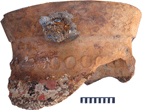
Fig. 1 - Pithoi Type I |
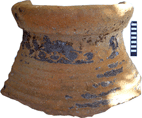
Fig. 2 - Pithoi Type II |
Amphora I, type 4 according to Dr. Nergis Gunsenin (Figure 3)
Most of the amphorae from the shipwreck belong to the widespread pear-shaped type with bowed handles. This type is well represented in the Eastern Mediterranean and the Black Sea basin in the twelfth and thirteenth centuries. They have almost no neck. The handles are oval in section and begin on the neck and rise above the rim before meeting the pot again on the body. The body is evenly and narrowly ribbed. The fabric is of various gradations of red. The toe (at the base) is well rounded but there are a few examples of this type of amphora with a flat bottom (Figure 4). Some amphorae are covered in an engobe, a slip of levigated white clay. This type of amphora varies in size. On most of the recovered amphorae, the pine cork stoppers (1.5 cm thick) have been preserved because the pot was buried in the seabed. On many examples, there are graffiti on the handles and walls. The graffiti mostly take the form of Greek letters, sometimes only one or two letters, sometimes spelling out a word (Figure 5. Figure 6). Other graffiti include dots, dashes, and pictorial symbols. On a few examples, dipinti, or painted symbols, can be seen on the body. It is difficult to decipher what the contents of this type of amphorae were. Such containers were used for liquids or dry goods such as cereals. We know from written sources that there was a large scale wine trade between Trabezon and other ports in the Black Sea in the thirteenth century, including the Crimea, so these amphorae may have been used to transport wine.
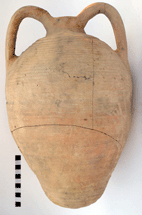
Fig. 3 - Amphora Type I |
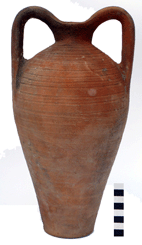
Fig. 4 - Amphora Type I |

Fig. 5 - Graffiti on an amphora wall |

Fig. 6 - Graffiti on an amphora wall |
Amphora II, type 3 according Dr. Nergis Gunsenin (Figure 7)
The next type of amphora has elongated handles that start at the rim and loop well above the neck before meeting the body again on the shoulder of the vessel. This type of amphora has almost as many names as there have been scholars who have studied it, but are most commonly known as Type III after Gunsenin. These were common in the Byzantine Empire from the twelfth-through fourteenth century. Like the first type, these too had stoppers, graffiti, and dipinti on handles and walls and served a similar function (Figure 8).

Fig. 7 - Amphora Type II |
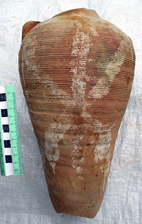
Fig. 8 - Amphora Type II |
Amphora III (Figure 9)
The third type is a small amphora with a ribbed, egg-shaped body, about 40 cm tall. The neck is very short and has an oval rim. The handles are flat and attached directly under the rim. The base is very distinctive. It is rounded on the edge and concave in the center. It is necessary to note that this type is finely made, unlike the previous types, and that all examples of this type contained thick resin residues, suggesting it was used for the transport of olive oil. An amphora analogous to this type is found in the thirteenth century strata at Constantinople.
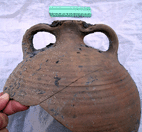
Fig. 9 - Amphora Type III |
Amphora IV (Figure 10)
The fourth type of amphora is relatively small, only 35 cm tall, and has with thick walls and a spindly body. The exterior is ribbed; it has a conical neck, and a rim with a rolled lip. This type of amphora was widespread in the Mediterranean and the Black Sea basin, but the analogous types in the Mediterranean are generally bigger. Excavations of the thirteenth-century strata at Constantinople and Akra in the Levant have revealed almost identical amphorae. These small amphora where believed to have been used for the transport of frankincense.
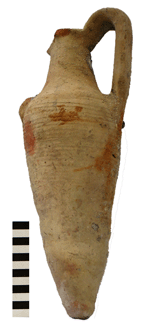
Fig. 10 - Amphora Type IV |
Amphora V (Figure 11. Figure 12)
The fifth amphora type is particularly interesting to scholars as it is rarely found in the excavations of thirteenth-century sites. It has a wide, short neck. The handles are round in section, beginning at the top of the neck directly below the rim and gently traveling down to the shoulders of the vessel. The upper part of the body is decorated with a unique incised wavy pattern.
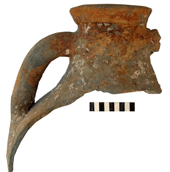
Fig. 11 - Amphora Type V |

Fig. 12 - Amphora Type V |
Kitchen ware (Figure 13. Figure 14)
We have found many plain vessels that were undoubtedly designed for utilitarian uses in or around the kitchen. It is worth mentioning that some examples of this pottery bear signs of fire and soot marks around the base. This may mean that some of these pots were used by the crew for cooking aboard the vessel. Occasionally pots are found that show signs of repair. In one example, the handle had snapped in the middle and was repaired using metal clamps. Such items must have been used heavily and considered valuable enough to repair rather than replace. Other examples show no signs of use, suggesting that they were also part of the cargo that was designated for trade. This type of pottery was common to the whole coast of the Black Sea during the Middle Ages, and has also been seen in the excavations of Constantinople.
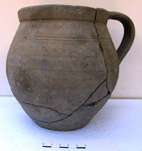
Fig. 13 - Pot |
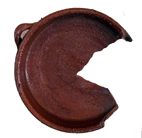
Fig. 14 - Frying pan |
Glazed Pottery
Introduction (Figure 15)
The cargo of glazed ware from the thirteenth-century shipwreck in Novy Svet represents a wide variety of pottery types. However the majority seems to correspond to only two types: the "Novy Svet Group" of unknown origin, and the "Green and Brown Glazed Ware" from Constantinople. Next to these two, the glazed ceramics present in smaller quantities originate from places as diverse as Venice in Italy, the Paphos region in Cyprus, Beirut in the Levant, and the Seldjuk territories of Anatolia. This collection of artifacts exhibits many types of tableware, including dishes, bowls, plates, goblets, beakers and jugs (Figure 16), and a total of eight different styles of decorative surface treatment. In addition, many of the vessels bear graffiti on the foot or wall (Figure 17), giving further clues to their areas of production. Evidence of how they were produced can be seen as well. The pottery was stacked in the kiln to save space and increase production. During firing, the pottery was separated by small ceramic tripod stilts to prevent the pots from sticking together when the glaze vitrified. The stilts left their mark in the form of three small dots in the form of a triangle that can still be seen on the walls of the interiors.
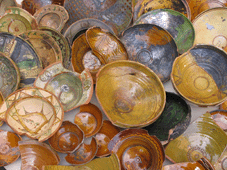
Fig. 15 - Glazed pottery collection |

Fig. 16 - Jug |
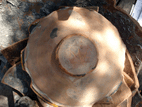
Fig. 17 - Graffiti on a plate |
Sgraffito
Originally graffita or a graffita in Italian, this name literally means "scratched" decoration. It was one of the most popular decorations in medieval glazed pottery in the Mediterranean and the Black Sea. "Sgraffito" probably derives from the term "sgraffiato" an English pseudo-Italian word used in the nineteenth century. The term is used for patterns incised into the whitish slip coating (or engobe) of a pot (before the second firing) exposing the contrasting reddish body underneath. Often, the pot was then covered with a translucent lead glaze that would highlight the incised decorations.
"Novy Svet" group (Figure 18. Figure 19)
We named this category the "Novy Svet" group after our site, as its origin is as yet unknown and no other site has produced more example of this type. This type of ceramic constitutes the bulk of the cargo of glazed pottery. It is well attested in the Crimea and can also be found in Turkey and the Levant. It was originally thought to have been produced at Nicea, but this idea is not supported by recent chemical analysis. This group is characterized by simple sgraffito decoration of concentric circles under a bright yellow-brown glaze and takes the forms of cups, plates, and bowls, all supported on a raised foot.
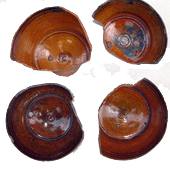
Fig. 18 - Novy Svet Group |

Fig. 19 - Novy Svet Group plate |
"Green and Brown Glazed Ware" (Figure 20. Figure 21)
Also known as Byzantine White Ware, this group makes up a significant portion of the ship's glazed cargo based the number of examples found so far. The interior is covered on the inside with a thick, white slip (or engobe) and then with a thin, transparent or light grey glaze. A decoration is painted on the top of the white slip before the application the glaze in green and various hues of brown. Decoration can be simple linear or spiral combinations, solid motifs, circles, animals, or human figures. Typically these vessels take open forms such as plates, bowls and jugs. Recent analysis has confirmed this type to be of Constantinopolitan origin.

Fig. 20 - Green and Brown Glazed Ware |
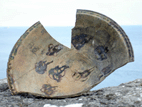
Fig. 21 - Green and Brown Glazed Ware plate |
"Zeuxippus Ware" (Figure 22)
Zeuxippus Ware takes its name from the Baths of Zeuxippus in Constantinople where it was first identified. A thickly applied white or cream slip and vitreous glaze covers the interior and the upper part of the exterior. There are several groups of this type and so far we have discovered many examples of it.

Fig. 22 - Zeuxippus Ware |
"Roulette Ware" (Figure 23)
Roulette Ware is the designation for a group of Northern Italian import wares with a particular kind of impressed decoration. There can be a white slip on the interior and on the upper part of the exterior. A yellow, green, or transparent glaze is applied thickly on the interior. Traces of tripod stilts are characteristic for this ware. The impressed decoration or rouletting on the exterior of the open bowls, mostly on its upper part, is made with a rotating instrument (a roulette) that produces a series of well-arranged indentations in parallel lines. Mainly this takes the form of a bowl and chemical analysis suggests it originates from the Venetian region of the Italian peninsula.

Fig. 23 - Roulette Ware |
"Anatolian" or "Seldjouk Ware" group (Figure 24)
This type of Islamic glazed pottery is common in Northeast Anatolia during the Seldjouk period. We have recovered several large plates of this ware from the site. More information concerning this group will follow pending further study.
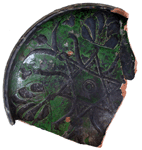
Fig. 24 - Anatolian or Seldjouk Ware |
Slip Pained Ware (Figure 25)
The interior is decorated with a white slip design painted under a pale yellow or yellow glaze. The painted design consists mainly of spirals and curved lines. This technique was well established in Greece by the Middle Byzantine period, but was also used later on. Common shapes include various forms such as jugs, plates, bowls, etc. It is currently believed to have originated in Cyprus.
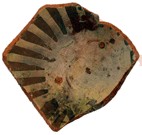
Fig. 25 - Slip Pained Ware |
Other Sgraffito (Plain, Monochrome and Color) Fine Wares (Figure 26 Figure 27)
Some of the best examples of the sgraffito technique occur when the overlying glaze highlights the incised decoration. Potters of the Palaeologan period developed the "Plain Sgraffito Ware" (Figure 26). This type of pottery uses an iron oxide colored glaze, resulting in hues from light yellow to orange-gold. Occasionally, a copper oxide glaze is used which results in various shades of green. Later potters, during the end of the twelfth to the beginning of the thirteenth centuries, used more color. This new type is referred to as "Colored Sgraffito Ware" (Figure 28). Brown-yellow iron oxide, green copper oxide, and brown-purple manganese oxide were applied to the engraved decorations with thick strokes and can be combined on the same vase. (Figure 27)

Fig. 26 - Plain Sgraffito Fine Ware |

Fig. 27 - Italian Fine Ware |
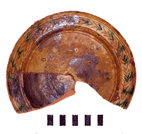
Fig. 28 - Color Sgraffito Fine Wares |
Wood, Rope, and Metal remains (Figure 29, Figure 30, Figure 31, Figure 32)
Because of the violent winter storms that pound the northern Black Sea coast and marine organisms that eat wood, there are few wooden remains found so far that can be positively linked to the ship. However, wood fragments have been found on the seabed, some of which are quite large in size. Many of these fragments are worked, showing signs of being carved, chopped, and cut. Such fragments, however scanty, can reveal important facts about a ship's construction. Wood samples have been sent to the Dendrochronology Laboratory in Verona, Italy, for analysis and dating. The results are pending. We have also discovered smaller artifacts such as carved wooden combs (Figure 32). The combs have fine teeth on one side of a spine and thicker teeth on the other and are often decorated with small circles. These combs are representative of ones from the medieval period. Equally tantalizing are strands of braided rope of various sizes and thicknesses, some measuring over a meter in length and several centimeters thick. The fragile condition of the stands suggests that they must be very old, and are perhaps remnants of the ships rigging. Further analysis of the fibers will hopefully confirm this theory. There are also a lot of bronze and iron artifacts that may have been the tackles or fasteners of the ship. Analysis of these may provide clues to the construction, rigging, and even handling of the ship. However, these metallic finds are heavily corroded, often obscuring the original shape or function of the artifact.

Fig. 29 - Wooden fragment |

Fig. 30 - Rope |

Fig. 31 - Corroded metal objects |

Fig. 32 - Wooden combs |
Other Ceramics
Small cups (Figure 33, Figure 34)
These served either as lids for larger vessels or a way for offering samples (tests) of food or other products for sale.

Fig. 33 - Small cup |

Fig. 34 - Small cup |
Spheroconus (Figure 35, Figure 36)
The so-called spheroconus was widespread in Asia Minor and surrounding territories in the Middle Ages. They are very thick globular vessels with only a small opening at the top through a protruding nipple. Their exact function is debated. One theory states that these vessels were used for the transportation and storage of mercury, an ingredient often employed in medieval medicine. A second theory claims they were used for carrying the holy water from the springs of Mecca. Finally, a third interpretation says they were employed in warfare as grenades. They small nipple opening would be useful for the dispensing of a liquid such as mercury or holy water, however its aerodynamic form suits a hand-held projectile well. Filled with naphtha, the conical vessels could be lit by a wick placed through the top of the nipple and thrown with a catapult or by hands, essentially as a firebomb. However the thickness of walls might refute this idea and, like those found in Novy Svet, they were often decorated in an attractive manner. Our vessels bear scaly decoration with some other elements that unfortunately have not been preserved. Such decoration seems to be more fitting on a consumable good rather than a military incendiary device. Despite their common occurrence in various excavations in Asia, our discovery of several fragments from two vessels (found in the same location) is the first time they have been seen in the Novy Svet area.
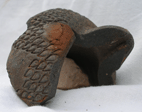
Fig. 35 - Spheroconus |
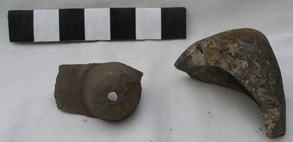
Fig. 36 - Spheroconus |
|

